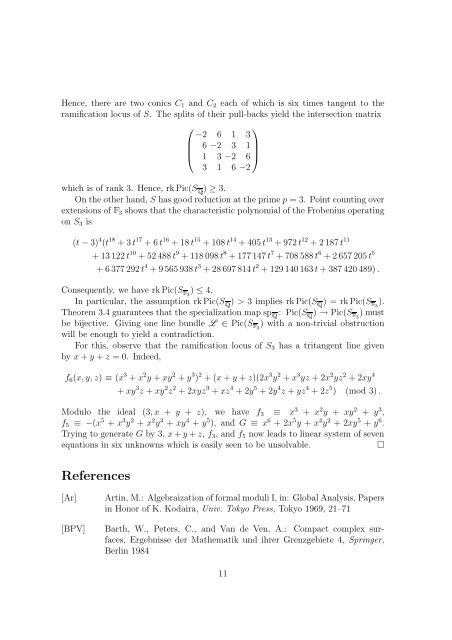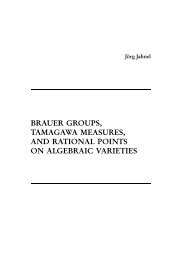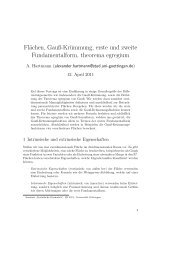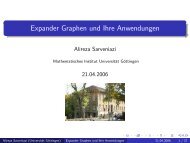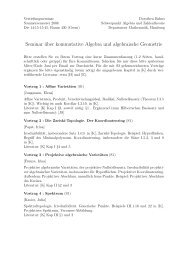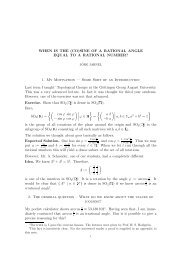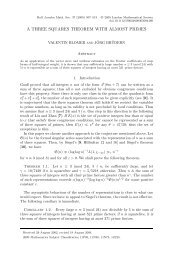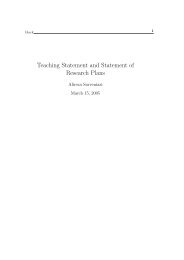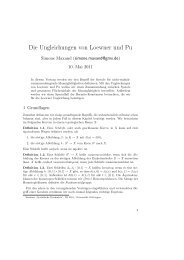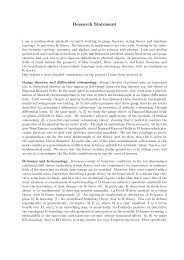The Picard group of a K3 surface and its reduction modulo p
The Picard group of a K3 surface and its reduction modulo p
The Picard group of a K3 surface and its reduction modulo p
You also want an ePaper? Increase the reach of your titles
YUMPU automatically turns print PDFs into web optimized ePapers that Google loves.
Hence, there are two conics C 1 <strong>and</strong> C 2 each <strong>of</strong> which is six times tangent to the<br />
ramification locus <strong>of</strong> S. <strong>The</strong> spl<strong>its</strong> <strong>of</strong> their pull-backs yield the intersection matrix<br />
⎛ ⎞<br />
⎜<br />
⎝<br />
−2 6 1 3<br />
6 −2 3 1<br />
⎟<br />
1 3 −2 6 ⎠<br />
3 1 6 −2<br />
which is <strong>of</strong> rank 3. Hence, rk Pic(SÉ) ≥ 3.<br />
On the other h<strong>and</strong>, S has good <strong>reduction</strong> at the prime p = 3. Point counting over<br />
extensions <strong>of</strong>3 shows that the characteristic polynomial <strong>of</strong> the Frobenius operating<br />
on S 3 is<br />
(t − 3) 4 (t 18 + 3 t 17 + 6 t 16 + 18 t 15 + 108 t 14 + 405 t 13 + 972 t 12 + 2 187 t 11<br />
+ 13 122 t 10 + 52 488 t 9 + 118 098 t 8 + 177 147 t 7 + 708 588 t 6 + 2 657 205 t 5<br />
+ 6 377 292 t 4 + 9 565 938 t 3 + 28 697 814 t 2 + 129 140 163 t + 387 420 489) .<br />
Consequently, we have rk ) ≤ 4. Pic(S3<br />
In particular, the assumption rk Pic(SÉ) > 3 implies rk Pic(SÉ) = rk ). Pic(S3<br />
<strong>The</strong>orem 3.4 guarantees that the specialization map spÉ: Pic(SÉ) → ) must Pic(S3<br />
be bijective. Giving one line bundle L ∈ ) with a non-trivial obstruction<br />
Pic(S3<br />
will be enough to yield a contradiction.<br />
For this, observe that the ramification locus <strong>of</strong> S 3 has a tritangent line given<br />
by x + y + z = 0. Indeed,<br />
f 6 (x, y, z) ≡ (x 3 + x 2 y + xy 2 + y 3 ) 2 + (x + y + z)(2x 3 y 2 + x 3 yz + 2x 2 yz 2 + 2xy 4<br />
+ xy 3 z + xy 2 z 2 + 2xyz 3 + xz 4 + 2y 5 + 2y 4 z + yz 4 + 2z 5 ) (mod 3) .<br />
Modulo the ideal (3, x + y + z), we have f 3 ≡ x 3 + x 2 y + xy 2 + y 3 ,<br />
f 5 ≡ −(x 5 + x 3 y 2 + x 2 y 3 + xy 4 + y 5 ), <strong>and</strong> G ≡ x 6 + 2x 5 y + x 4 y 2 + 2xy 5 + y 6 .<br />
Trying to generate G by 3, x + y + z, f 3 , <strong>and</strong> f 5 now leads to linear system <strong>of</strong> seven<br />
equations in six unknowns which is easily seen to be unsolvable.<br />
□<br />
References<br />
[Ar]<br />
[BPV]<br />
Artin, M.: Algebraization <strong>of</strong> formal moduli I, in: Global Analysis, Papers<br />
in Honor <strong>of</strong> K. Kodaira, Univ. Tokyo Press, Tokyo 1969, 21–71<br />
Barth, W., Peters, C., <strong>and</strong> Van de Ven, A.: Compact complex <strong>surface</strong>s,<br />
Ergebnisse der Mathematik und ihrer Grenzgebiete 4, Springer,<br />
Berlin 1984<br />
11


